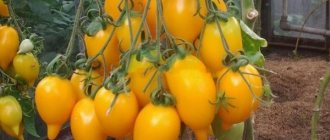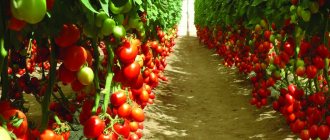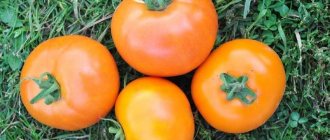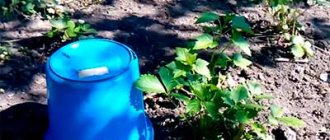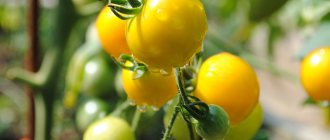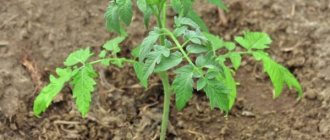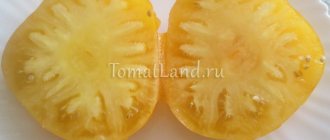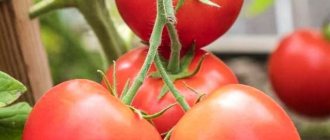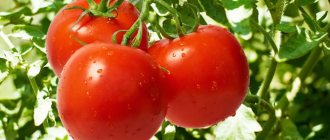Description of the variety
The Golden Queen tomato is an indeterminate variety. The growing season is 95-105 days. The bushes grow tall and are formed into 1-2 stems. The leaves are medium in size, dark green in color. The fruits have a flat-round shape, filling up to the size of a man’s fist. The color of tomatoes is unusual – honey-yellow. Due to their hypoallergenic properties and excellent taste, tomatoes are recommended for dietary and baby food.
Tomato agricultural technology is standard; even an inexperienced gardener can cope with cultivation. This is due to the plant’s unpretentiousness and high resistance to common nightshade diseases.
Golden Queen tomatoes on video
If you grew Golden Queen tomatoes from a Siberian garden, please write whether you liked them or not. What was the yield and taste of the fruit under your conditions? Briefly describe the advantages and disadvantages of this tomato in your opinion. If possible, attach a photo of the entire bush or individual fruits you grew to your comment. Thank you!
Your reviews of the Golden Queen tomato and additions to the description will help many gardeners evaluate this variety more objectively and decide whether it is worth planting or not.
Distinctive features
The variety is recommended for cultivation in open ground and under film cover. The bush grows rapidly, reaching a meter in length. This requires the installation of a support and a garter. Stepping up to the first brush is also carried out.
Tomatoes are grown using seedlings. The peculiarity of the variety is its ability to set fruit even under unfavorable weather conditions.
The variety was bred by Siberian breeders. The result of their work was a plant with hypoallergenic properties and a delicious taste.
Yellow and tasty tomato in your beds - description of the Golden King tomato variety
This variety will undoubtedly interest all lovers of large yellow tomatoes.
Possessing a number of remarkable properties, it is easy to care for and produces a good harvest.
This is the “Golden King”, this wonderful variety will be discussed.
- Tomato “Golden King”: variety description
- Advantages and disadvantages
- Fruit characteristics
- Photo
- Features of cultivation
- Diseases and pests
- Conclusion
Tomato “Golden King”: variety description
This type of tomato was bred in Russia in 2007. It received state registration as a variety in 2009, and since then has gained popularity among lovers of large-fruited yellow tomatoes.
This is a mid-early variety of tomatoes; approximately 100 days pass from planting seedlings to the appearance of the first fruits of varietal maturity.
The bush belongs to the determinant, standard type.
It is recommended by experts for cultivation in film shelters, but it is also possible in open ground.
The “Golden King” tomato variety has quite good yield. With good care and the correct planting scheme, you can get per square meter. meters in greenhouse conditions up to 8-10 kg of excellent fruits. In open ground, productivity does not drop significantly.
Advantages and disadvantages
Among the main advantages of this variety, amateurs and professionals note:
- large fruit;
- good yield;
- resistance to major diseases;
- high taste qualities;
- wonderful yellow color.
Information: Among the disadvantages, it is noted that the branches of this bush require especially careful care to avoid breaking them.
Fruit characteristics
- Ripe tomatoes are yellow in color and heart-shaped.
- They are quite large in size, 400-600 grams, but there are also real giants, 800 grams each.
- Number of cameras 6-7,
- dry matter content is 5-6%.
These tomatoes are very good fresh. They also make a very tasty, vitamin-rich juice.
They are not used for preservation because they are too large. Representatives of this tomato variety are also very good in barrel pickling.
Other table tomato varieties presented on our website: Lapwing, Fat Bosun, Goldfish, Domes of Russia, Pride of Siberia, Ogorodnik, Alpha, Bendrik's Cream, Raspberry Miracle, Heavyweight of Siberia, Monomakh's Cap, Zhigalo, Golden Domes, Velmozha, Honey Candy, Koenigsberg, Stresa, Black Russian, Heart of Ashgabat, Cranberry in Sugar, Shady Lady, Pink Bush.
Features of cultivation
For outdoor cultivation, southern regions such as the Astrakhan region, Crimea or the North Caucasus are more suitable for this species. In greenhouse shelters it is possible to grow in conditions of the middle zone, the yield does not decrease or decreases slightly.
Among the features of this variety are its large fruit and yellow color, which is unusual for many.
It is also worth noting its resistance to many diseases.
When growing, branches are pruned to form two stems; supports and branch garters are actively used to support the branches.
Harvested tomatoes tolerate storage and transportation well.
List of tomato varieties that are well stored and can be transported: “Maryina Roshcha”, “Large Cream”, Pink Paradise, Eagle’s Beak, Bear’s Paw, “Red Icicle”, “Honey Cream”, “Orange Miracle”, “Lyana”, “ Siberian early ripening", "Heavyweight of Siberia", "Russian domes", "Friend F1", "Sugar cream", "Premium F1", "Orange Miracle", "Blagovest F1", "Tarasenko Yubileiny", Gift of the Volga region, Khokhloma, Etoile , Moskvich, Mazarin, Sweet bunch.
Diseases and pests
Although the “Golden King” is resistant to disease, in rare cases it can be susceptible to a disease such as fomoz.
To get rid of this disease, it is necessary to remove the affected fruits, and the branches should be sprayed with the preparation “Hom”. They also reduce the amount of fertilizers containing nitrogen and reduce watering.
Dry spot is another disease that can affect this tomato variety.
The drugs Antrakol, Consento and Tattu are used against it.
In open ground, this tomato is often attacked by slugs and mole crickets.
Against slugs, use a solution of hot pepper with dry mustard, 1 spoon per square meter. meter, after which the pest will leave. They fight mole crickets by weeding the soil and using the drug “Gnome”.
Greenhouses are often subject to whitefly infestation. The drug “Confidor” will be actively used against it.
Conclusion
Tomatoes of this type are not very difficult to care for. It is enough to follow simple rules regarding temperature and watering conditions, tie and support the branches, then the harvest will please you. Good luck to you.
We invite you to watch a video about yellow varieties of tomatoes, including the “Golden King” tomatoes:
Fruit characteristics, yield
The fruits are set in small clusters of 3-4 tomatoes. Flat-round tomatoes have pronounced ribbing in the stalk area. The skin is a rich honey-yellow color. The pulp is moderately dense, contains a lot of juice and a small amount of seeds. The taste is sweetish with fruity notes.
Reference! Tomatoes contain many useful micro and macroelements. The fruit is recommended for allergy sufferers, children and people on a diet.
The average weight of a tomato grown in a greenhouse reaches 700 g. In garden beds in open ground, fruits weighing 300-400 g are considered record holders. Among the giants, the Golden Queen occupies a leading position. With proper care, 6-10 kg of selected tomatoes are harvested from one bush.
Unique fruits
Tomatoes of this variety have many positive characteristics.
Size range
The Golden Domes variety is famous for the size of its fruits. The average weight for all collections is almost half a kilogram
It is important that the tomatoes do not become too small, even in the very top bunches gaining 200 grams. The first inflorescences pour giants of 700 - 800 grams
Description of the tomato variety Thick cheeks and its characteristicsRead
As a rule, each brush bears an average of 5 ovaries. The yield declared in the State Register is at least a bucket per square meter of planting. Experienced tomato growers harvest even more. For example, Petukhova Oksana Viktorovna from the Moscow region grew two roots in one hole, and each hole yielded 6 - 7 kilograms of large tomatoes.
Form
There are two types of tomatoes on one Golden Dome plant. The very first, largest, as a rule, are round, flattened above and below, moderately ribbed from the stalk. Subsequent ones have the shape of a dome or heart.
Ugly fruits are very rare; most are smooth, beautiful, and have an attractive presentation. Non-standard, gnarled ovaries sometimes form in greenhouses and in extreme heat. It is not in vain that the variety is recommended mainly for open ground, since it is adapted to cool temperature conditions.
Coloring
Unripe tomatoes have a dark green spot on top that gradually disappears as they ripen. The skin acquires a golden shine and a special color - first yellow, then light orange. Within one cluster, the fruits are not painted all at once, but one at a time. Being picked unripe, they ripen well in storage.
Diet pulp
Some people talk about honey sweetness, mention a fruity or grape note, others feel a slight sourness and citrus aroma, and for some the Golden Domes are a little bland.
The density is also characterized in different ways: from fleshy to starchy and loose, but it is never too watery. Obviously, plants planted in different climatic conditions exhibit a unique, complex range of tastes. The seed chambers are always small, there are not too many seeds.
We can say with confidence that the variety does not have high acidity, therefore it is suitable for dietary nutrition. In addition to lycopene, which is traditional for tomatoes, orange tomatoes accumulate large amounts of carotene.
Usage
Golden domes are especially good in fresh salads. Tomatoes cannot be stored for a long time, but, being moderately juicy and dense, they perform excellently in preparations such as ketchup, lecho, and adjika. The juice turns out thick—reminiscent of fruit juice with pulp. Sterilized salads made from layers of different colors look original. For those who practice ancient barrel pickling, the large size of the fruit is not a hindrance.
Description of the tomato variety German red strawberry, its characteristics and yieldRead
Seeds
You can use planting material either purchased or prepared yourself. The store-bought option is preferable, since the grains have already been processed. They only need to be soaked immediately before planting. It is important to prepare the harvested seeds:
- sort (select only large specimens without deformation or damage);
- test for germination in a saline solution (5 g of table salt per 100 ml of water);
- disinfect (in a weak solution of potassium permanganate);
- treat with a growth stimulator (Epin, Zircon).
Priming
The seed develops well in loose, fertile soil. You can use universal soil or prepare a soil mixture from the following components:
- garden soil (1 part);
- peat (2 parts);
- humus (0.5 parts);
- coarse sand (0.5 parts);
- wood ash (1 cup);
- fertilizer per 10 kg of soil (15 g of potassium ingredient, 10 g of urea, 30 g of superphosphate).
Reference! Before mixing with other components, garden or vegetable soil should be calcined in the oven for disinfection. You can also pour boiling water over it.
Sowing
The prepared soil is moistened and allowed to stand for a couple of hours. Then the surface is slightly loosened, grooves 1 cm deep are formed, seeds are planted at a distance of 3-4 cm. The same interval is observed between the grooves.
After sowing, the container is covered with transparent polyethylene or glass. The planting should be placed in a warm room (average temperature 25°). Every day the film is removed for half an hour for ventilation. As the soil dries, it is moistened using a spray bottle.
After about 4-7 days, shoots appear. From this moment you need to remove the shelter and place the container in a cooler place (the temperature should first be 18-20°, then 14-16°). Young shoots require good lighting. The duration of daylight hours should be 12-16 hours.
When irrigating seedlings, do not allow water to get on the greens.
The first fertilizing is introduced 2-3 weeks after emergence. For these purposes, organic matter or special humic compositions are ideal.
Picking is done after the formation of 2-3 true leaves on the shoots. Each sprout, along with a lump of earth, is transferred into disposable cups. After 2-3 weeks, the picking is repeated, but in a larger container.
How to grow seedlings
Properly prepared seedlings guarantee a rich harvest. Take this stage as carefully as possible. Buy seeds for seedlings in a store or order online .
On the packaging, the manufacturer provides a brief description of the variety and recommendations for cultivation.
Seed preparation
Treat the seeds with a solution of potassium permanganate. This will disinfect their surface and destroy dangerous microorganisms. It is assumed that store-bought material has already been pre-treated with special preparations. However, it is better not to risk it and do it again yourself. For convenience, place the seeds in a fabric bag and immerse them in the solution for 20 minutes.
Next, the seeds need to be germinated. Germination is necessary to check the degree of germination of the material and accelerate its development. If during the germination stage you notice that some seeds have not sprouted, get rid of them immediately.
For germination you will need gauze and polyethylene. Wrap the seeds in slightly damp gauze and place in plastic. Make sure that the gauze does not dry out. At the same time, avoid over-watering.
Important ! For the fastest germination, it is recommended to use growth stimulants. “Kornevin” is recognized as an effective remedy. Soak the seeds in the solution for 6 hours. “Kornevin” will not only protect the crop from diseases, but will also accelerate the growth of young roots.
Container and soil
Any clean and dry container is suitable for seedlings. Peat pots are the most popular among gardeners. They are environmentally friendly and affordable, and also maintain the required level of moisture. Sold in any specialized store. In addition to peat containers, flower pots or wooden boxes, as well as similar containers, are suitable for seedlings.
The soil is either purchased at the store or prepared independently. Ready-made soil has a number of advantages, the main ones:
- it contains accessible macro- and microelements that plants need;
- the earth contains the necessary microflora;
- distinguished by ease;
- absorbs water well and retains it;
- has an optimal level of acidity.
Among ready-made soils, the mixtures “Shchedra Zemlya”, “Krepysh”, “Bogatyr”, and “Magic Bed” are especially popular. When purchasing, trust only trusted manufacturers with a good reputation. It would be a good idea to consult with your gardener friends and find out what mixture they use for seedlings.
Sowing
Prepare the seedlings 50-60 days before planting on the site. Place drainage at the bottom of the container, add soil and water with warm, settled water. When the water is absorbed, make holes 1-2 cm deep. Sow seeds in them and sprinkle soil on top.
The optimal distance between seeds is about 3 cm. If the soil is dry, spray it with a spray bottle. Cover the containers with a lid and place in a warm, lit place.
Growing and care
The temperature should be no lower than 20-23 degrees.
After the first shoots appear, the lid must be removed. The seedlings should stand in a bright place, otherwise arrange additional lighting using lamps. The first watering is 10 days after planting the seeds. Only settled warm water is suitable for irrigation.
As soon as the first leaves appear, feed the seedlings. Liquid bird droppings or the drug “Fitosporin” are suitable for this. This protects the plant from possible diseases and strengthens the immune system.
In the future, it is recommended to feed tomatoes every 10 days.
How to grow tomatoes
The seedlings are transferred to open ground after the threat of night frosts has passed. The seedlings are transferred to the greenhouse after they reach a height of 25-35 cm. By this time, 8-10 true leaves are formed on the shoots, and the root system is well developed. A couple of weeks before planting, the seedlings are taken outside for hardening. The procedure is carried out daily with a gradual increase in time from 30 minutes to 2 hours.
The variety will become the highlight of the garden bed - Golden Queen tomato: description of tomatoes and characteristics
The seeds of the Golden Queen are not sown directly into the beds. First you need to grow seedlings. To do this, you should prepare a container of appropriate volume, planting material and soil mixture.
READ MORE: Pickled garlic arrows: winter recipes with photos and videos
The seedlings are transferred to open ground after the threat of night frosts has passed. The seedlings are transferred to the greenhouse after they reach a height of 25-35 cm. By this time, 8-10 true leaves are formed on the shoots, and the root system is well developed. A couple of weeks before planting, the seedlings are taken outside for hardening. The procedure is carried out daily with a gradual increase in time from 30 minutes to 2 hours.
The Golden Queen tomato will be a real treasure on the farmers' plot. The variety not only looks royal, but also has a great taste worthy of royalty.
| Height | Landing location | Ripening time | Fruit color | Fruit size | Origin | Fruit shape |
| Tall | Greenhouse, Open ground | Early ripening | Yellow | Average | Variety | Flat-round |
Golden Queen is an indeterminate tall variety. The bushes are spreading and branched, the shoots are strong and long. Branching and foliage are above average.
- honey-golden color;
- average weight 150-200 g;
- the pulp is fleshy, sugary;
- the taste is sweet with light notes of sourness;
- the skin is strong;
- transportability and keeping quality are good.
Landing
The beds are laid out according to the following pattern: 70x70 cm. The bushes of an adult plant are spreading, so there is no need to thicken the planting. This will complicate care. For rapid adaptation of seedlings and intensive growth, you need to prepare the soil. In addition to disinfection, it will need to be enriched with fertilizer, sand and peat if there is an increased density.
First, water is poured into the prepared holes, after which the seedling is installed. Use gentle movements to bury it, lightly pressing the soil. After irrigation, the beds are lightly loosened and covered with mulch.
Care
Further care follows standard rules of agricultural technology. There are some nuances regarding bush shaping and pinching. The information is presented in the table.
| Tomato care measures | ||
| Name | Regularity | Features of the event |
| Watering | 1-2 r. per week, in hot weather daily | Irrigation should begin 3-5 days after planting. Next, the mode is set taking into account the degree of soil moisture. |
| Weeding, loosening | Once every 2 weeks or as needed | Loosening is done after watering to avoid crust formation. Weeds attract parasites and provoke the development of fungus. It is advisable to combine both procedures to save time. |
| Stepsoning | + | Carry out until the first flower brush. |
| Bush molding | + | The bush is formed in 1-2 stems. |
| Garter | + | It is carried out to the support in several stages as the bush grows. |
| Top dressing | After planting, apply 3 times. | 1st time 10 days after planting (a mixture of mullein 0.5 liters and nitrophoska 15 ml per bucket of water); 2nd time after 3 weeks. (mineral fertilizers with nitrogen, phosphorus and potassium); 3rd time after 2 weeks. (potassium-phosphorus composition) |
Caring for Golden Bull tomatoes
- When the fruits ripen, remove old, dried leaves.
- Water with settled, warm water in the evening when the soil dries out.
- To prevent diseases and better development, add 3 pinches of wood ash to a bucket of water when watering.
- After watering, loosen the soil.
The variety is practically not susceptible to diseases, but its enemy can be the Colorado potato beetle. If it is detected on a bush, treatment with insecticides is sufficient, following the instructions.
The yield of one saturated bush is 10 – 12 kg.
Tomatoes are good for children and those on a diet due to their high content of carotene, lycopene and vitamins.
The main use of the fruit is fresh. They are not entirely suitable for pickling due to their large size, unless they are chopped.
Having analyzed all the features of the fruit, we can conclude that this crop is unusual. When growing, you do not need a lot of time and experience in special equipment.
Sources
- https://MoeFermerstvo.ru/tomat/sort/zolotaya-koroleva
- https://FermoVed.ru/pomidoryi/zolotaya-koroleva-i-korol.html
- https://rusfermer.net/ogorod/plodovye-ovoshhi/tomat-pomidor/rannespelye-sorta/zolotaya-koroleva.html
- https://repka.online/ovoshhi/tomaty/srednerannie/zolotoy-korol.html
- https://DachaMechty.ru/tomat/sort/zolotoj-korol.html
- https://otomate.ru/zolotoj-byk.html
- https://rusfermer.net/ogorod/plodovye-ovoshhi/tomat-pomidor/srednerannie-sorta/zolotoj-korol.html
- https://siog.ru/77-v-poiskah-urozhaynyh-sortov-tomatov.html
- https://otomate.ru/zolotaya-korolev.html
- https://ogorod-bez-hlopot.ru/tomat-zolotoj-byk.html
- https://MoeFermerstvo.ru/tomat/semena/zolotoj-byk
- https://sornyakov.net/vegetables/tomaty-zolotoj-korol-vse-o-zheltyx-krasavcax-s-potryasayushhim-vkusom.html
Features of cultivation and possible difficulties
After planting, the seedling quickly gains growth. If the plant develops poorly, you need to introduce nitrogen fertilizers. It is also important to regulate watering.
During the flowering period of potatoes, garden crops are affected by the Colorado potato beetle. It often takes a liking to tomato bushes, which can lead to the destruction of the planting. To prevent the problem, it is recommended to regularly inspect the beds to identify beetles or larvae. If a large population is found, insecticide treatment should be carried out.
The greatest difficulties arise with stepchildren. They need to be removed almost weekly for the bush to form correctly. You will also need to pay attention to the garter. Otherwise, under the influence of winds or under the weight of filling fruits, the branches will break.
Diseases and pests
The Golden Queen tomato is characterized by strong immunity. Resistance is shown to common diseases of nightshade plants. As a preventive measure against tobacco mosaic, late blight, and fusarium wilt, the following measures are recommended:
- disinfect the greenhouse surfaces and soil before planting (use a solution of potassium permanganate or copper sulfate);
- spray the beds with late blight products (copper-containing preparations);
- regularly ventilate the greenhouse, avoiding drafts;
- carry out weeding and loosening of the soil;
- spread a layer of mulch on the ground to protect the soil from drying out.
Plants need to be systematically inspected for pests. The following parasites pose a danger to planting:
- whitefly;
- thrips;
- slugs;
- aphid;
- bear
When insects or their metabolic products are detected, it becomes necessary to spray the beds using insecticides. You can get rid of the Colorado potato beetle by collecting larvae and adults manually. If this does not help, they resort to treating the tomatoes with special means.
The nuances of growing in open ground and in a greenhouse
The Russian-bred Golden Queen tomato is intended for growing in a greenhouse. In warm regions it is successfully cultivated in open ground. If you choose the option under cover, you need to consider the following recommendations.
- The root system of tomatoes can be improved by enriching the soil with oxygen and nitrogen. Nitrogen compounds are applied before the flowering period. Later, potassium-phosphorus fertilizers are used. You can open access to oxygen by loosening or planting between rows of legumes.
- The taste of the fruit improves if basil is planted around the perimeter of the tomato beds. The tomatoes will acquire a brighter aroma and richer taste.
- To prevent infection by fungal diseases, it is recommended to ventilate the greenhouse daily. But at the same time, it is important to avoid drafts, especially until the seedlings get stronger.
When cultivating tomatoes in open ground, it is advisable to install a drip irrigation system. This method is suitable not only for moistening the soil, but also for introducing nutritional compounds and fertilizing. This irrigation option simplifies the care of the beds. In order to prevent parasites, plants that repel pests should be planted between the rows. These are: marigolds, parsley, thyme, sage, etc.
Harvesting and application
When Golden Queen seedlings are planted in May, the fruits reach technical maturity in the second half of July. Tomatoes in a greenhouse ripen a couple of weeks earlier than in open ground. The harvest period is not prolonged due to the friendly formation of ovaries and ripening. Vegetables can be stored for a long time when placed in a cool place.
One of the advantages of the variety is the universal use of fruits. They are suitable for preparing many culinary dishes. Due to their large size, tomatoes are rarely used whole for twists. However, tomatoes are ideal for fresh salads and winter preparations, where the fruit is chopped into slices. The pulp produces a thick and tasty juice; it is also prepared for consumption during the cold season.
Page 3
Before you purchase weighed or packaged seeds, you need to select them. Which ones are right for you depends on where they will be planted, as well as on the region and many other factors.
If you are a beginner gardener, you should choose hybrids. In our catalog you can find a lot of options:
- Cucumber “Mimino F1”;
- Corn "LS 779";
- Beijing cabbage "Kingfisher F1";
- Sweet pepper "Barbie F1"
If you decide to choose a variety rather than a hybrid, we offer the following seed options in professional packaging:
- Eggplant “Almaz” (ripens in 100-110 days);
- Detroit beets (80 days);
- Tomato “Pink Newcomer” (120 days);
- Dill “Moravan (Totran)” (35-40 days).
Delivery is carried out by mail to any point in Ukraine.
Advantages and disadvantages of the variety
The Golden Queen is well known to summer residents and owners of greenhouse complexes. The variety is popular due to the following advantages:
- large fruit;
- excellent taste;
- early ripening;
- unpretentiousness to agricultural technology;
- stable high yield;
- strong immunity;
- high content of amino acids, sugar and other nutrients;
- Possibility to grow in open ground and under cover.
When growing a variety, some disadvantages should be taken into account:
- the need for pinching, bush shaping;
- mandatory soil fertilization (intensive growth and formation of large fruits requires constant feeding with nutrients);
- garter to supports (a tall, spreading plant may break under the weight of the fruit).
Tomato King of the Market - full review of the variety
The King of the Market variety was developed by Russian breeders in the early 2000s. Initially, it was developed for the needs of industrial production, so first of all, the tomato gained popularity in the large market. However, soon its positive qualities were noted by ordinary farmers.
It appealed to many professional gardeners and summer residents, causing them a large number of positive reviews, and the originator - an incentive to select new hybrids specifically for owners of small gardens.
Since the introduction of the first Market King, this series has expanded significantly and now has 13 officially registered representatives. Although the new varieties differ from their ancestor, in general all tomatoes of this variety have similar properties.
Distinctive features
Most varieties of the variety are classified as hybrids for open ground - 9 out of 13 tomatoes of the King of the Market variety are determinate.
The exceptions are four indeterminate varieties: Pink Market King No. 8, Giant King No. 9, Pickling King No. 11 and Honey King No. 12. They are suitable for planting both in open ground and in greenhouses.
Photos of varieties of the King of the Market variety:
In determinate tomatoes of this type, the bush is low-growing and slightly stretches upward. The growth stage quickly ends with a flower cluster. Such a bush grows to a maximum of 100 cm. Indets reach up to 1.5 m in height.
In both subspecies, during growth the bush forms two stems. They grow strong and thick, but, nevertheless, they still need to be tied up due to the abundance and heaviness of the fruit.
According to professional breeders, tomatoes of the King of the Market F1 variety have the following advantages:
- grow well in arid climates;
- tolerate sudden fluctuations in temperature and humidity without problems;
- resistance to the main complex of tomato diseases and cracking;
- rarely become an object of interest for pests;
- uniform and abundant harvest on all bushes;
- suitable for consumption both fresh and processed;
- Thanks to their thick skin, they tolerate transportation and storage well.
Among the disadvantages, gardeners from non-southern regions point out their increased heat-loving nature - such tomatoes germinate more slowly and set trusses in the middle zone, but it is not recommended to grow them in the northern regions.
Many summer residents also find a disadvantage in the fact that “kings” cannot be preserved in their entirety due to their large fruits. However, they are gladly used for drying, barrel or tub salting.
Fruit characteristics and yield
Almost all fruits of the King of the Market variety are visually similar. In appearance, all representatives of this variety are perfectly even and smooth. The taste of the fruit, starting with Market King No. 4, was improved, so later hybrids are distinguished by a sweet taste and aroma, as well as juicy and elastic pulp.
When ripe, tomatoes acquire a bright red color and have a round, slightly elongated shape. Tomatoes of other colors were specially bred in the series - Pink Market King No. 8 and Orange Market King No. 13. Obvious differences in shape are observed in the King of the Market No. 2 and in the King of Salting No. 11 - they have a cylindrical shape, similar to cream.
As for the weight of fruits, on average it varies from 180 to 300 g. The varieties King of the Market No. 7 and King Giant No. 9 stand out from the general picture with fruit weights of 400-600 and 400-1000 g, respectively.
The yield of the Market Kings is average among other hybrids - from 9 to 13 kg per 1 m². The average fruit yield per bush is extremely high – 92%.
Photos of unusual varieties of the King of the Market variety:
Farmer reviews
- Semyon Ilyich, Krasnodar region
When planting seedlings in a greenhouse, I immediately install supports. The growth of the shoots is intense, so I carry out the first level of garter 3 weeks after planting. The plant responds well to fertilizer. I use both mineral and organic compounds. Late blight destroyed the beds with Volgograd tomatoes and Rufus. The landings with the Golden Queen remained intact.
- Antonina, Moscow region.
Tomatoes fully live up to their name. The Golden Queen is perfectly cultivated in open ground. I cover the seedlings with film only at night, when there is a threat of late frosts. I really like the presentation and taste of the tomato. This is the second year I have been preparing tomato puree for the winter for my little granddaughter. Nutritionists say that the variety is good for babies. I spoil my adult children on weekends with pizza, which I also prepare using the Golden Queen. It is possible to remove no more than 7 kg of fruit from the bush.
- Elena, Rostov region.
In general, the Golden Queen variety bears fruit well, but requires regular feeding and pinching. I consider the disadvantage of this variety to be the formation of a large number of stepsons; they have to be removed almost every week. Among the advantages: stable yield, disease resistance, understandable agricultural technology.
Video review of the variety:
